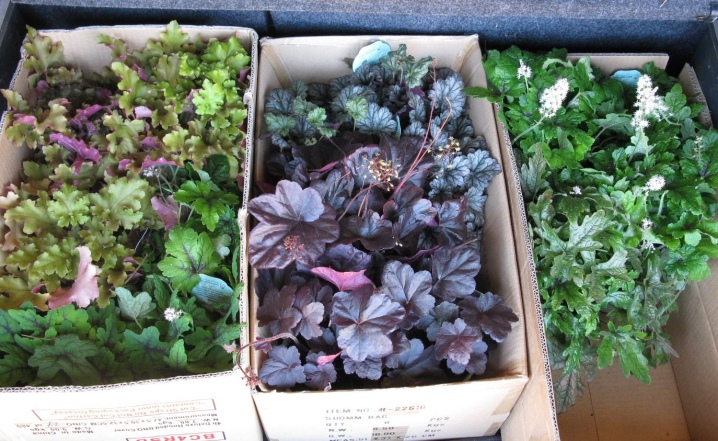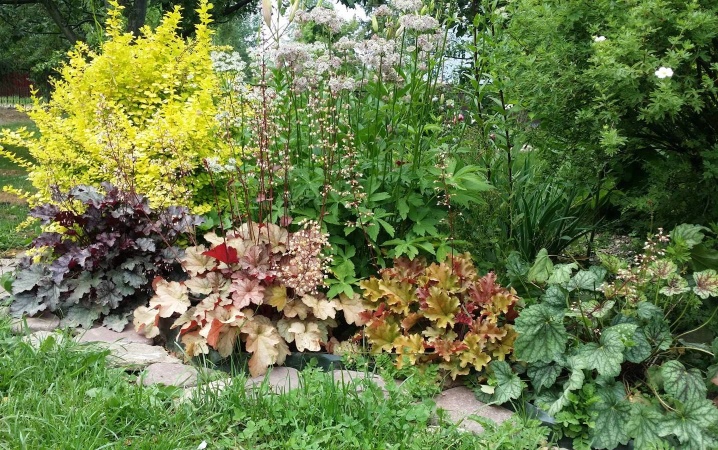How to grow Heuchera from seeds?

Geykhera is a perennial belonging to the Saxifrage family. Florists like this plant for its decorative appearance and abundant flowering. It is very difficult to pass by interesting leaves, painted in different colors, so it is not surprising that many growers decorate their gardens with a plant. It is not so difficult to grow Heuchera from seeds, it is enough to find out some of the nuances.

Variety selection
Currently, over 400 varieties of Heuchera are known. Moreover, this figure is constantly growing. Every year 10-30 new copies appear. Breeders by crossing breed more and more vivid varieties of this plant. However, gardeners have favorite varieties that they prefer to all others.
- One of these is grade "Gypsy violin", which is known for its frost resistance. The height can be 40 centimeters. The flowers are red and white in color, and resemble bells in location and shape.

- "Carmine-red" Heuchera - bright and memorable. Its red leaves with jagged edges are very conspicuous. They become especially colorful after the first frost. The flowers of this variety are small, red in color. It is worth emphasizing that flowering occurs in the summer months.

- A variety called "Comet" stays in memory for a long time. Leaves of rich green color and bright red flowers look very expressive. This Heuchera is loved for its special unpretentiousness. A decorative border from this variety looks great.

- Geichera "Dying Fire" attracts attention with its unusual leaves. The color is dark red with a purple or black tint really resembles a dying fire. The plant looks especially good in alpine slides.

- The variety "Purple Castle" has a spectacular appearance., which is also resistant to frost and unpretentious care. This plant belongs to the type of small-flowered heuchera and stands out with purple leaves with a burgundy tint. The shape of a maple leaf gives a special charm.

Timing
Seed propagation is usually carried out in the spring. However, experts say that it is possible to sow Heuchera before winter. In this case, it is important to choose not too high a temperature. Otherwise, the seeds may not tolerate the coming frosts well. Especially if they grow, since the newly formed sprouts are not very frost-resistant.
When planting in late autumn, you do not need to cover the ridges. If everything is done correctly, then the plant will rise the next year, around the end of May - beginning of June. It is worth noting that with this method, a stronger and hardened heuchera will be obtained.
When sowing seeds, it is important to take into account the climatic zone, since from it the spring planting can be carried out in March or May. The main thing is to make sure that the last frosts are no longer threatening, and the temperature will stay at the plus mark even at night. At the same time, it is necessary to sow seeds in nutritious and moist soil. Moreover, the crops are not covered with a layer of soil, but only slightly pressed into the prepared layer.
Seeds germinate best in the first 6 months after being harvested. The later they are planted after harvest, the worse they will emerge. Do not use seeds that were harvested 18 months ago, as they are unlikely to germinate.


In open ground, it is better to plant plants that are 1-2 years old. This is done in order to make it easier to organize a shelter for the flowers when frost sets in. When the first shoots appear, the plant is thinned out, and transplanted onto a permanent bed already with the onset of autumn or next spring.
With the appearance of the first shoots, plants can be thinned out, and sent to their permanent place of residence in early autumn or next year in spring.

Soil and seed preparation
Florists with experience in choosing Heuchera seeds rush not only to stores, but also to collectors. Most often, the choice is made on those varieties that can be propagated vegetatively. Collectors find it very difficult to grow a good ornamental plant from seed. However, they are best suited for various experiments.
You can collect seeds from a large and liked plant. The collection of seed should be carried out even before the first frost occurs. If the summer was pretty cool or there was too much rain, then you should not expect all the seeds to ripen equally well. In this case, it is better, after collecting, to fold them in a cardboard box or in a paper envelope for ripening. When choosing seeds in the store, it is important to look at the shelf life, which should be no more than 6-18 months. You also need to pay attention to the packaging. Indeed, in paper, the shelf life is shorter than in foil packaging.

Geichera is an undemanding plant, but to see it in all its glory, you should try to find the right place for it. This type gives preference to partial shade, for example, the space under the spreading deciduous crowns. It is important that the selected area is protected from wind and drafts. It is worth trying and highlighting such a corner in which only the morning rays of the sun will fall on the Heuchera.
You should not choose lowlands for this plant, in which ground and sedimentary water can accumulate. This can cause the roots of the plant to die. An important point is soil drainage so that moisture is quickly absorbed into the ground, and the root system does not rot. Lime soils are also not suitable for Heuchera.
The optimal soil for growing a plant is neutral or slightly acidic with a lot of organic matter. For a short time, cultivation in alkaline or acidic soil is allowed. As a basis for cultivation, you can take peat, leaf humus, garden and sod land.
It is good if the soil will allow a sufficient amount of moisture and air to pass to the root system. It is worth noting that in their homeland, which is North America, plants grow in rocky ground.

Coarse sand or vermiculite can be added to the soil to improve drainage. Soils, poor in nutritional value, can also become the basis, but in them Heuchera will not show all its attractiveness. During digging, humus can be added to such soil, as well as compost in proportions of 10 kilograms per square meter. You can grow seedlings already in a ready-made substrate, which is characterized by versatility. You can buy it at garden stores. To make the mixture better, you can add some sand to it. For about 10 parts of the substrate, add 1 part of sand.


If a self-made substrate is used, then it must be treated with a potassium permanganate solution or calcined in the oven. This is necessary to disinfect the soil. The same should be done with sand, which is added to the store soil. Often, vermicompost mixed with coconut fiber is taken in the form of soil for heuchera. Moreover, for 1 part of humus, 2 parts of fiber are taken. This type of soil also needs a disinfection procedure.
To accelerate germination, the seeds are soaked for 2-3 hours before sowing, and then dried to avoid sticking. If sowing is not carried out in open ground, then it is also important to choose the right containers.
It is best to opt for plastic or wood containers. There must be holes at the bottom, and expanded clay can serve as drainage.

Landing scheme
Growing heuchera at home is not a complicated process, but it is time-consuming. It is advisable to be patient, since all the beauty of this plant will be revealed only after 3 years. Sowing seeds for seedlings is as follows.
- The prepared soil must be poured into previously prepared containers. To the edges of the container should remain free 1.5-2 cm.
- Next, you should moisten the soil using a spray bottle.
- Then spread the seeds treated with the fungicide over the surface of the ground. It is convenient to first pour the seeds onto a sheet of paper folded in half, and then tilt it towards the ground and gently sow with light taps.
- Cover the seed on top with a thin layer of sand. It is desirable that the thickness of the top layer does not exceed 8 mm.
- Each container with seeds must be covered with glass or foil and placed in a warm place with good lighting. The optimum temperature for plant germination is 20 degrees. It will be possible to remove the shelter in 3-4 weeks, when the Heuchera not only rises, but also gets stronger.
- While the seedlings are covered with a film, it must be periodically raised for airing for 30 minutes. This is necessary so as not to expose the plant to fungal diseases.
- With the emergence of seedlings, holes are made in the film. In the event that the seedlings are covered with glass, then they are slightly raised.
- With the appearance of 3 leaves, a dive is carried out. Plants should be 5 centimeters apart.
- It is important to maintain the moisture content of the soil so that it does not dry out, but also does not become overly flooded. For young sprouts, spraying using a spray bottle is sufficient.



Seedlings must be hardened before planting in open ground. For this, the plants are taken out into the shade, where there is no wind and drafts. At first, the time in the air should be no more than 30 minutes, and then gradually increase. This should be done until the Heuchera adapts to the new conditions.
It is necessary to plant seedlings in holes that are 25 centimeters apart from each other. The hole should be 1.5 times larger than the root of the seedling with a lump of soil. It is advisable to put a little expanded clay on the bottom of the grooves before planting and place the seedlings directly on it.
It is important that the bud remains above the soil surface. Then you need to sprinkle the seedling with earth and compact the earth around the planting. At the end, it is worth watering each well well.

Further care
Taking care of a Heuchera is not very difficult, following some tips. It is worth noting that a plant of this type is resistant to diseases and most pests.... For thin roots, the danger is weevil, and for the leaves - slugs.
It is advisable to water the flower as the top layer of the soil dries up. In a normal summer, it is enough to water 2 times every 7-10 days. During periods of excessive drought, water will have to be watered 2 times a day, in moderate portions. It is necessary to pour water directly under the root, if splashes get on the leaves, they will lead to burns.
Loosening is done after watering, while weeds are removed. To simplify the care process, you can mulch with organic matter, for example, peat or compost. Also, mulch can be used in cold weather or during periods of heavy rain.
Heuchera needs to be fed regularly, with alternating organic and mineral fertilizers. It is optimal to carry out top dressing a couple of times a month. As for mineral fertilizers, it is advisable to dilute them 2 times stronger than indicated on the package. Better results can be achieved by feeding less frequently, but in smaller doses.

For information on how to grow Heuchera, see the next video.







































































































The comment was sent successfully.